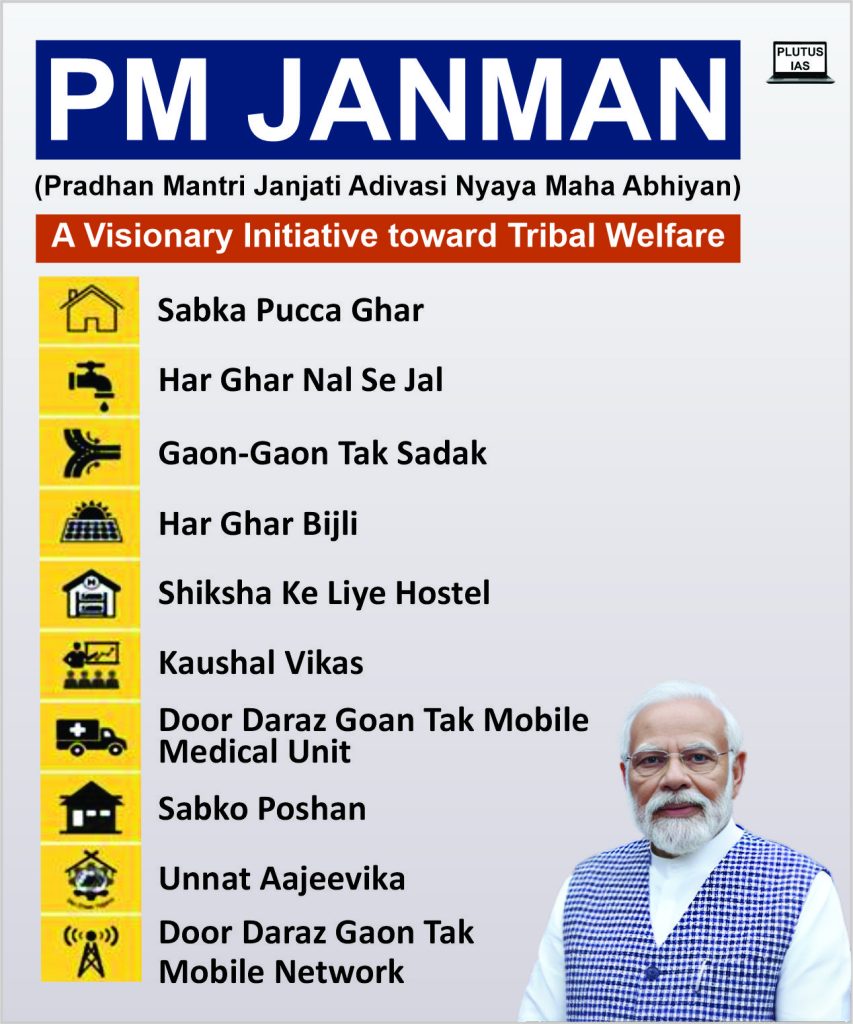16 Jan PM JANMAN Scheme
PM JANMAN Scheme
This article covers ‘Daily Current Affairs’ and the topic details of “PM JANMAN Scheme’’. This topic is relevant in the “Social Issues and Governance” section of the UPSC CSE exam.
UPSC GS1 and GS 2 MAINS Syllabus : Social Empowerment, Welfare schemes for vulnerable sections of the population by the Centre
Why in the News?
In continuation of its tribal policy, the government will distribute the first installment of Rs 540 crore for pucca dwellings to one lakh beneficiaries under the PM-JANMAN. On this occasion, the Prime Minister will digitally interact with the beneficiaries of PM-JANMAN, the flagship central project inaugurated in November 2023 for the socioeconomic welfare of especially vulnerable tribal groups (PVTGs).
About PM JANMAN scheme
- PM JANMAN is an Indian government programme that tries to integrate tribal groups into society.
- The scheme (which includes both Central Sector and Centrally Sponsored Schemes) would be executed in partnership with state governments and PVTG communities by the Ministry of Tribal Affairs.
- The project will focus on 11 important interventions that will be managed by 9 Ministries, ensuring the execution of existing schemes in PVTG communities.

- It includes safe housing under the PM-AWAS Scheme, access to clean drinking water, enhanced medical care, schooling, nourishment, road and telecommunications connectivity, and opportunities for sustainable livelihoods.
- The plan also calls for the setting up of Van Dhan Vikas Kendras for the trading of forest produce, off-grid solar power systems for 1 lakh families, and solar street lights.
- The plan is expected to improve the PVTGs’ quality of life and well-being by addressing their various and intersecting forms of discrimination and exclusion, as well as recognising and respecting their unique and priceless contribution to national and global development.
Implementation Difficulties:
- The lack of updated data on PVTGs is a serious barrier, as the most recent available census data for PVTGs is from 2001, when there were around 27.6 lakh people in these groups. Although the Ministry of Tribal Affairs has begun baseline surveys, an accurate and up-to-date dataset of PVTG populations has yet to be compiled. The lack of current data makes it difficult to accurately assess the needs and progress of PVTG communities.
- The complexity and diversity of PVTG needs and capacities among regions and states, as well as the necessity for customised and flexible approaches and interventions.
- The stigma and discrimination experienced by PVTGs in mainstream society and the state, as well as the necessity for enlightenment and public awareness among stakeholders and the general public.
- The scheme’s coordination and convergence with current schemes and programmes of the federal and state governments, as well as the necessity for effective and efficient delivery and utilisation of resources and services.
The circumstances in which the PM-JANMAN was launched
- According to the 2011 census, India is home to a ST population of 10.45 crore, with 75 PVTG groups distributed in 18 states and the UT of Andaman & Nicobar Islands.
- The Dhebar Commission revealed discrepancies among Scheduled Tribes in 1960-61, resulting in the introduction of the Primitive Tribal Groups (PTG) category.
- PVTGs – pre-agricultural lifestyles, low literacy, tiny or stagnant populations, and subsistence economies – were renamed in 2006.These PVTGs keep on encountering social, economic, and educational challenges.
- As announced in the Budget Speech 2023-24, to boost the socio-economic circumstances of the PVTGs, the PM PVTG of Development Mission is going to be launched.
- As a result, PVTG families and habitations will be fully supplied with basic amenities like secure housing, hygienic drinking water, and increased access to healthcare, nutrition, and education.
- By the Development Action Plan for the Scheduled Tribes (DAPST), Rs. 15 billion would be made available to carry out the Mission over the following three years.
Download plutus ias current affairs eng med 16th Jan 2024
Prelims practice question
Q1) Examine the following claims on India’s Particularly Vulnerable Tribal Groups (PVTGs):
1) 18 States along with one Union Territory are home to PVTGs.
2) One of the factors used to determine PVTG status is a population that is either stationary or declining.
3) Thus far, 95 PVTGs have been formally notified throughout the nation.
4) The tribes of Konda Reddi and Irular are listed as PVTGs.
Which of the statements given above are correct?
(a) 1, 2 and 3
(b) 2, 3 and 4
(c) 1, 2 and 4
(d) 1, 3 and 4
Answer: C
Q2) Which of the following statements regarding Particularly Vulnerable Tribal Groups (PVTGs) is correct?
1) PVTGs are not entitled to any special protection or privileges.
2) PVTGs are identified based on criteria such as pre-agricultural technology, low literacy rates, and a stagnant or declining population.
3) PVTGs have unrestricted access to mainstream education and healthcare services.
Which of the following statements are incorrect?
- A) 1 only
- B) 2 only
- C) 1 and 3
- D) 2 and 3
Answer: D
Mains practice question
Q1) Describe the socio-economic challenges faced by PVTGs in accessing education and healthcare services. How can these challenges be addressed to improve their overall well-being?
Q2) Discuss the criteria used for the identification of Particularly Vulnerable Tribal Groups (PVTGs) and explain why these criteria are considered important for their recognition.
I am a content developer and have done my Post Graduation in Political Science. I have given 2 UPSC mains, 1 IB ACIO interview and have cleared UGC NET JRF too.



No Comments